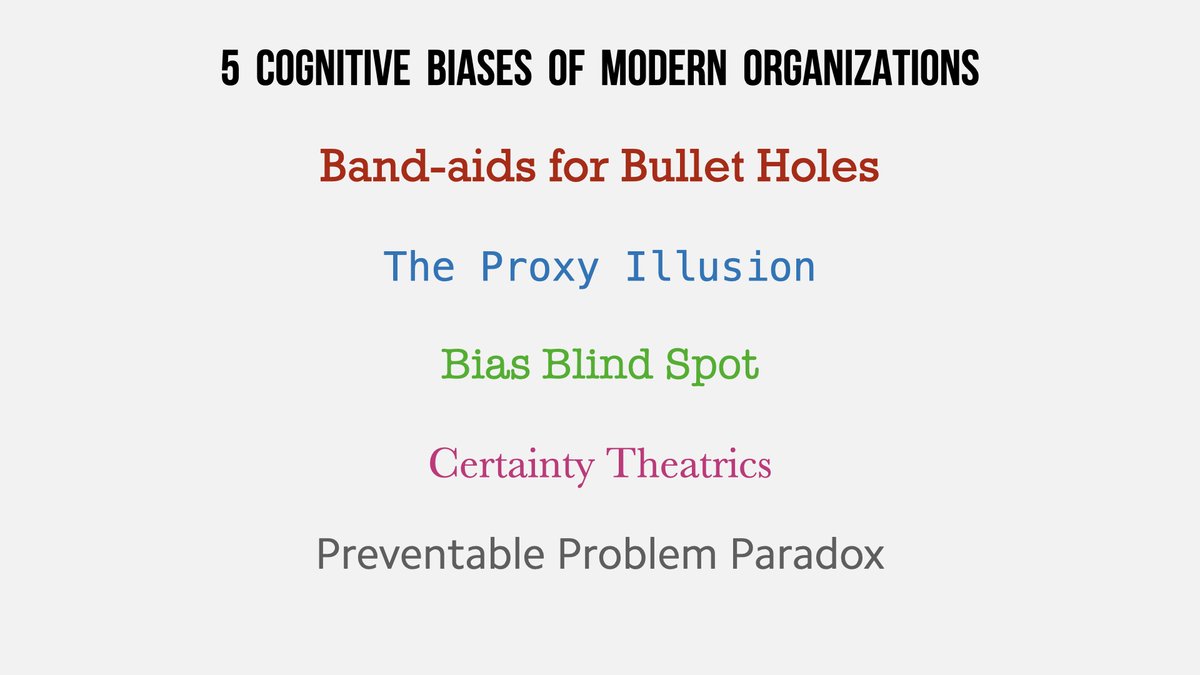Why do many modern teams & companies fail to achieve the clarity, progress, and results they so badly seek?
5 cognitive biases of modern organizations, a thread:
5 cognitive biases of modern organizations, a thread:
1/ Band-aids for Bullet Holes
Organizations tend to prefer sticking band-aids on serious bullet holes.
They do this due to 3 reasons:
- irrational optimism that the band-aid will work
- inability to diagnose the actual problem
- avoidance of the pain from fixing said problem
Organizations tend to prefer sticking band-aids on serious bullet holes.
They do this due to 3 reasons:
- irrational optimism that the band-aid will work
- inability to diagnose the actual problem
- avoidance of the pain from fixing said problem
e.g.
Most Execution problems are really
1) Strategy problems, or
2) Interpersonal problems, or
3) Culture problems
Good leaders execute well because they understand this. They fix the root problem.
Bad leaders & their teams struggle because they are always applying band-aids.
Most Execution problems are really
1) Strategy problems, or
2) Interpersonal problems, or
3) Culture problems
Good leaders execute well because they understand this. They fix the root problem.
Bad leaders & their teams struggle because they are always applying band-aids.
h/t @taylorswift13 for saying “band-aids don’t fix bullet holes” (song: Bad Blood)
2/ The Proxy Illusion
As they grow in size & complexity, organizations tend to confuse the proxy for a thing for the thing itself.
As they grow in size & complexity, organizations tend to confuse the proxy for a thing for the thing itself.
Example:
The tragedy of most product organizations is that a 3 week delay for a product launch will cause much greater stress & scrutiny than an ill-conceived feature in the very same product.
On-time launch is often seen by sr mgmt as a proxy for the team’s product competence.
The tragedy of most product organizations is that a 3 week delay for a product launch will cause much greater stress & scrutiny than an ill-conceived feature in the very same product.
On-time launch is often seen by sr mgmt as a proxy for the team’s product competence.
See this tweet for more examples of The Proxy Illusion within organizations: https://twitter.com/shreyas/status/1255489241364279299">https://twitter.com/shreyas/s...
3/ Bias Blind Spot
When organizations are making decisions, they rarely consider what cognitive biases might be affecting their decision quality.
After organizations have made a bad decision, they rarely consider their own cognitive biases as being a potential root cause.
When organizations are making decisions, they rarely consider what cognitive biases might be affecting their decision quality.
After organizations have made a bad decision, they rarely consider their own cognitive biases as being a potential root cause.
4/ Certainty Theatrics
A surprisingly high fraction of every corporation’s time & resources are spent on pretending to itself that it is a highly rational entity that is capable of creating absolute certainty even in inherently uncertain situations.
A surprisingly high fraction of every corporation’s time & resources are spent on pretending to itself that it is a highly rational entity that is capable of creating absolute certainty even in inherently uncertain situations.
The reality:
Some degree of uncertainty is a part and parcel of any complex business. The pressure for Certainty Theatrics at high-stakes meetings is at the root of many bad decisions.
Some degree of uncertainty is a part and parcel of any complex business. The pressure for Certainty Theatrics at high-stakes meetings is at the root of many bad decisions.
Cortisol for Creativity (a corollary):
The trouble with most companies is that they give their employees a big dopamine hit for exhibiting their Analytical Intelligence in meetings but a cortisol rush for exhibiting their Creative Intelligence.
The trouble with most companies is that they give their employees a big dopamine hit for exhibiting their Analytical Intelligence in meetings but a cortisol rush for exhibiting their Creative Intelligence.
5/ Preventable Problem Paradox
Any complex organization will over time tend to incentivize problem creation more than problem prevention.
This bias leads to a “hero culture”, avoidable blunders & general execution slowness
A superb illustration of this bias by @_workchronicles
Any complex organization will over time tend to incentivize problem creation more than problem prevention.
This bias leads to a “hero culture”, avoidable blunders & general execution slowness
A superb illustration of this bias by @_workchronicles
Alright, what can you do with all of this, as a manager or a leader?
The 4 vital steps you can take:
1) notice how these biases sneak into your organization’s work
2) share these biases & the vocabulary with your team
3) create the necessary psychological safety for them to point out these biases
4) take corrective action where it makes sense
1) notice how these biases sneak into your organization’s work
2) share these biases & the vocabulary with your team
3) create the necessary psychological safety for them to point out these biases
4) take corrective action where it makes sense
Overall:
Understand
Observe
Act on the important stuff
I hope the awareness of these cognitive biases can be of some help in making your organization wiser and its people happier.
Best of luck to you!
Understand
Observe
Act on the important stuff
I hope the awareness of these cognitive biases can be of some help in making your organization wiser and its people happier.
Best of luck to you!
Back to the top of this thread: https://twitter.com/shreyas/status/1391594501437751301">https://twitter.com/shreyas/s...

 Read on Twitter
Read on Twitter



